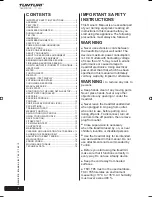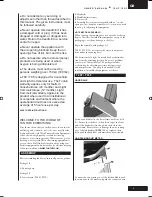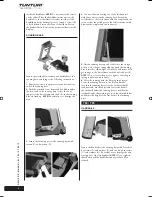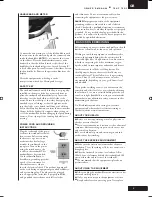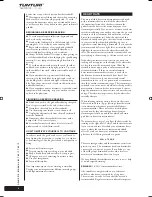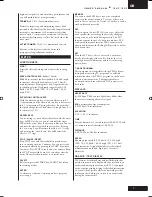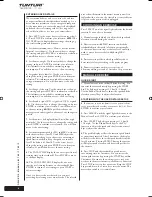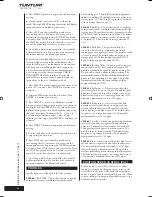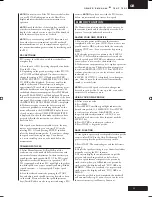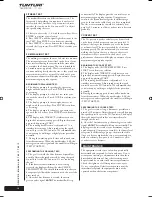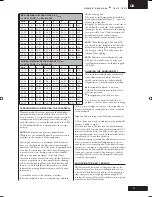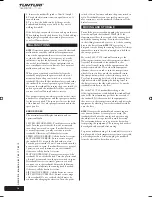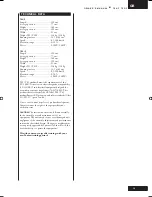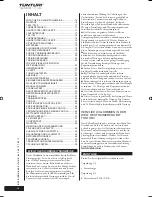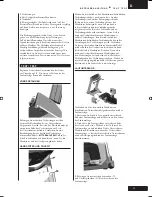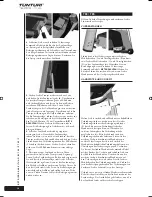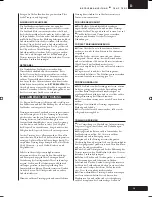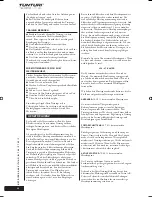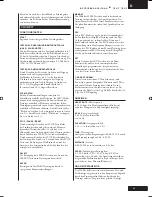
6
OWNER’S MANUAL
•
T80/F T85/F
hands, feet or any other objects under the treadmill.
•
Wear appropriate clothing and shoes when exercising.
Make sure your shoelaces are properly tied. To avoid
injury and unnecessary wear on your treadmill, be sure
your shoes are free of any debris such as gravel and small
pebbles.
BEGINNING AN EXERCISE SESSION
•
To avoid muscular pain and strain, begin and end
each workout by stretching.
•
Stand on the landing rails to the left and right of the
running belt. Do not stand on the running belt.
•
Begin each workout at a low speed, and gradually
increase your speed and/or treadmill elevation to a
comfortable level according to your condition.
•
Always hold the handrail for support when getting on
or off the treadmill and when changing the speed during
exercise. Do not jump off the running belt while it is
moving!
•
To avoid numbness and pain in the neck, shoulder
and back area, maintain an upright posture. Try to run
in the middle of the track, within comfortable reach of
the meter.
•
If you encounter any operational faults during
exercise, grip the handlebar for support and stand on
the landing rails to the left and right of the running
belt. Turn the power switch off and see the instructions
under Malfunctions.
•
If you experience nausea, dizziness or other abnormal
symptoms while exercising, stop your workout at once
and consult a physician.
FINISHING AN EXERCISE SESSION
•
Finish each workout by gradually reducing the speed.
Don’t forget to stretch at the end of the workout.
•
Never leave the safety key in the treadmill.
•
Use the main power switch to turn the unit off.
•
Unplug the electrical cord from the wall outlet and
from the treadmill.
•
If necessary clean the treadmill from sweat with a
damp cloth. Do not use solvents.
•
Store the electrical cord where it is clear from all
pathways and out of childrens’ reach.
HOW TO MOTIVATE YOURSELF TO CONTINUE
In order to reach the goals you have set, you’ll need to
keep finding the motivation to continue so you achieve
your ultimate goal: life-long health and a new quality of
living.
•
Set yourself realistic targets.
•
Progress step-by-step according to your schedule.
•
Keep a fitness diary and write down your progress.
•
Change your way of exercising from time to time.
•
Use your imagination.
•
Learn self-discipline.
One important aspect of your training is versatility.
Varying your training exercises different muscle groups
and helps maintain motivation.
HEART RATE
The most reliable heart rate measurement is achieved
with a telemetric device, in which the electrodes of
the transmitter fastened to the chest transmit the
pulses from the heart to the meter by means of an
electromagnetic field. If you want to measure your heart
rate this way during your workout, moisten the grooved
electrodes on the transmitter belt with saliva or water.
Fasten the transmitter just below the chest with the
elastic belt, firmly enough so that the electrodes remain
in contact with the skin while pedalling, but not so
tight that normal breathing is prevented. If you wear the
transmitter and belt over a light shirt, moisten the shirt
slightly at the points where the electrodes touch the
shirt. The transmitter automatically transmits the heart
rate reading to the meter up to a distance of about 1 m.
If the electrode surfaces are not moist, the heart-rate
reading will not appear on the display. If the electrodes
are dry, they must be moistened again. Allow the
electrodes warm up properly to ensure accurate heart
rate measurement. If there are several telemetric
heart rate measurement devices next to each other,
the distance between them should be at leas
t 1.5
m.
Similarly, if there is only one receiver and several
transmitters in use, only one person with a transmitter
should be within transmission range. The transmitter is
switched to an active state only when it is being used for
measurement. Sweat and other moisture can, however,
keep the transmitter in an active state and waste battery
energy. Therefore it is important to dry the electrodes
carefully after use.
When selecting training attire, please note that some
fibers used in clothes (e.g. polyester, polyamide) create
static electricity, which may prevent reliable heart
rate measurement. Please note that a mobile phone,
television and other electrical appliances form an
electromagnetic field around them, which will cause
problems in heart rate measurement.
No matter what your goal, you’ll get the best results by
training at the right level of effort, and the best measure
is your own heart rate. First find your maximum heart
rate i.e. where the rate doesn’t increase with added
effort. If you don’t know your maximum heart rate,
please use the following formula as a guide:
208 – 0,7 X AGE
These are average values and the maximum varies from
person to person. The maximum heart-rate diminishes
on average by one point per year. If you belong to one
of the risk groups mentioned earlier, ask a doctor to
measure your maximum heart rate for you.
We have defined three different heart-rate zones to help
you with targeted training.
BEGINNER:
50-60 % of maximum heart-rate
Also suitable for weight-watchers, convalescents
and those who haven’t exercised for a long time.
Three sessions a week of at least a half-hour each is
recommended. Regular exercise considerably improves
T80_T85_manual.indd 6
23.3.2004, 15:56:33
Summary of Contents for T80
Page 116: ...116 O W N E R S M A N U A L T 8 0 F T 8 5 F T80 T85 ...
Page 118: ...T85 F T80 F PROFILES ...
Page 119: ......


